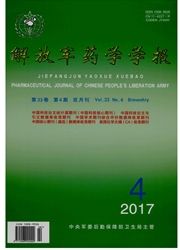

 中文摘要:
中文摘要:
目的观察芍药苷对辐射损伤内皮细胞保护作用的分子机制。方法 10Gy60Coγ照射前1h给予内皮细胞芍药苷,采用逆转录聚合酶链反应、免疫组化以及免疫印迹等方法检测细胞间黏附分子1、血管细胞黏附分子1的表达。结果人脐静脉内皮细胞经10Gy60Coγ照射后与正常组细胞相比,活性氧,丙二醛水平明显上升,谷胱甘肽,超氧化物歧化酶水平明显降低,黏附分子mRNA与蛋白的表达明显升高;随着芍药苷给药浓度的变化,加药组细胞中活性氧,丙二醛水平逐渐降低,谷胱甘肽,超氧化物歧化酶水平逐渐升高;免疫组化的结果显示芍药苷可降低辐射引起的黏附分子的表达,逆转录聚合酶链式反应检测显示芍药苷可降低辐射引起的黏附分子的mRNA的表达,Westernblot检测显示芍药苷可降低辐射引起的黏附分子的蛋白表达水平。分子信号通路的研究表明,芍药苷通过影响JNK通路进一步抑制激活物蛋白1与目的基因的结合。结论芍药苷通过抑制JNK细胞核激酶-激活物蛋白通路进而抑制黏附分子表达,这可能是芍药苷对辐射损伤内皮细胞保护作用的分子机制。
 英文摘要:
英文摘要:
Objective To observe the protective effect of paeoniflorin on endothelial cells injured by radiation.Methods Human umbilical vein endothelial cells were pretreated for 1 h with paeoniflorin and then exposed to 10 Gy radiation.The expressions of intercellular cell adhesion molecule 1,vascular cell adhesion molecule 1 were detected by reverse transcription-polymerase chain reaction,immunohistochemisty and Western blotting.Results Compared with irradiated group,administration of paeoniflorin could increase reactive oxygen species and the malondialdehyde level while decreasing cellular glutathione and superoxide dismutase.Immunohistochemical and western blot analysis results showed that paeoniflorin could inhibit expressions of intercellular cell adhesion molecule 1,vascular cell adhesion molecule 1 at protein levels,while ranscription-polymerase chain reaction results showed that this happened at gene levels.The effect of paeoniflorin on adhesion molecules expression was mediated by the blockade of c-Jun N-terminal kinase and the combination of activing factor 1 and target gene.Conclusion Paeoniflorin could inhibit oxidation and cell adhesion by inhibiting expressions of adhesion molecules.Jun nuclear kinase-activing factor 1 pathways play a key role in cell protection of paeoniflorin.
 同期刊论文项目
同期刊论文项目
 同项目期刊论文
同项目期刊论文
 期刊信息
期刊信息
